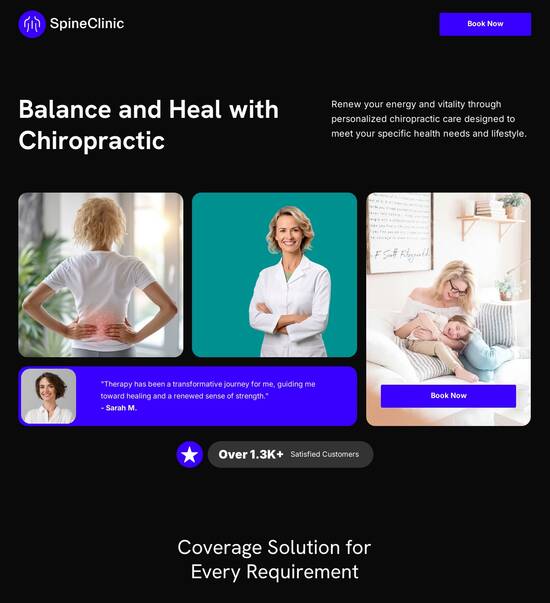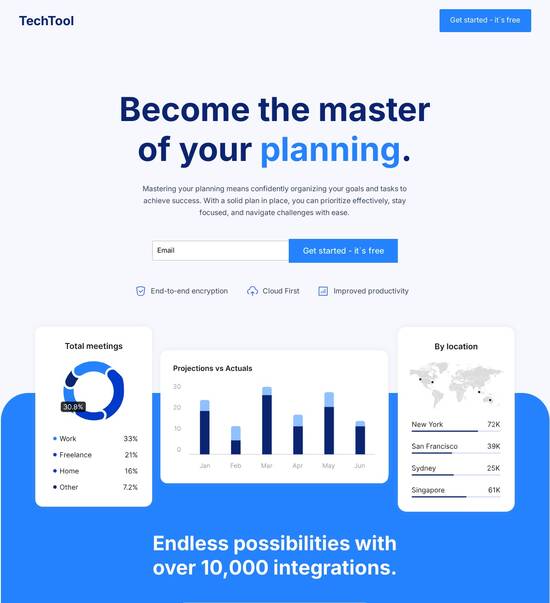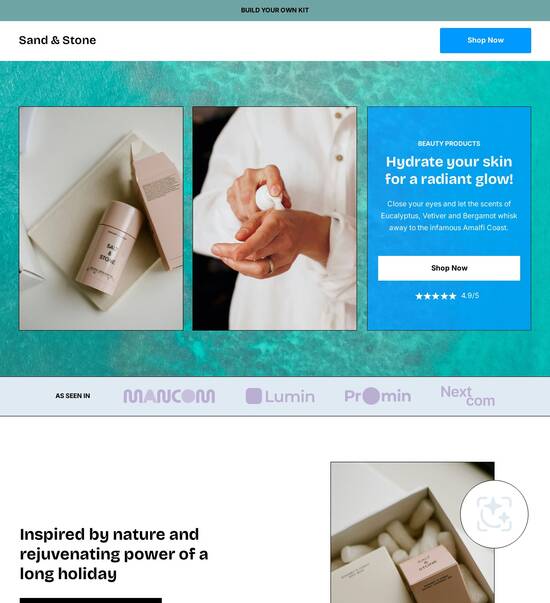
React.js optimized our services page template
Explore Similar TemplatesAbout template
Supercharge your our services page with React.js for outstanding performance! Learn more today.
Recommended templates

Easy to build without coding
With the intuitive drag-and-drop builder, anyone on your team can create high-converting pages without any knowledge of code or design. Make enhancements to your landing page with custom widgets using Javascript, HTML/CSS, or third-party scripts.

Multiple layouts for any industry and goal
Select from 500+ landing page layouts built to boost conversions across industry-specific scenarios. Customize them by adjusting fonts, adding images, and generating on-brand content with the AI assistant. Quickly scale with Instablocks® and Global Blocks that you can save, reuse, and update globally.

Loads fast and looks polished on any device
Every template is responsive, which means they present professionally on any device and load blazingly fast with our Thor Render Engine. You can also power them up with Google AMP technology to deliver an unparalleled mobile experience and drive higher conversions.

Robust analytics & experimentation
Get real-time updates and reporting across all your devices, showing the number of visitors, conversions, cost-per-visitor, and cost-per-lead. Launch AI-powered experiments, run A/B tests, and use heatmaps to analyze user behavior, then optimize your landing page to maximize conversions.







Easy to build without coding
With the intuitive drag-and-drop builder, anyone on your team can create high-converting pages without any knowledge of code or design. Make enhancements to your landing page with custom widgets using Javascript, HTML/CSS, or third-party scripts.
Multiple layouts for any industry and goal
Select from 500+ landing page layouts built to boost conversions across industry-specific scenarios. Customize them by adjusting fonts, adding images, and generating on-brand content with the AI assistant. Quickly scale with Instablocks® and Global Blocks that you can save, reuse, and update globally.
Loads fast and looks polished on any device
Every template is responsive, which means they present professionally on any device and load blazingly fast with our Thor Render Engine.
Robust analytics & experimentation
Get real-time updates and reporting across all your devices, showing the number of visitors, conversions, cost-per-visitor, and cost-per-lead. Launch AI-powered experiments, run A/B tests, and use heatmaps to analyze user behavior, then optimize your landing page to maximize conversions.
All the features you need to build our services page reactjs
Explore more featuresLearn how to build top-performing landing pages for any goal
FAQs
Leading the way in building high-performing landing pages





Maximizing ROI with Instapage's powerful landing page and CRO platform
As marketers strive to create efficient and high-converting campaigns, Instapage emerges as the leading platform for landing page and conversion rate optimization (CRO). By utilizing intuitive tools and robust features, you can accelerate your marketing efforts and maximize your return on investment effectively.
Utilizing templates and lead generation elements
Instapage offers over 100 customizable templates designed to boost conversion rates and enhance lead capture. These templates come with pre-built lead generation elements that allow marketers to launch effective campaigns swiftly. You don’t need to be a developer; the platform’s user-friendly drag-and-drop builder simplifies the process.
- Diverse template selection: Choose from industry-specific designs that cater to various markets, making it easier to appeal to your target audience.
- Integrated lead capture features: Use forms, buttons, and embedded elements that facilitate the immediate collection of visitor information.
- Adaptive responsiveness: Ensure that your pages look great on all devices, enhancing the user experience and increasing the likelihood of conversion.
Optimizing landing pages for performance
Instapage excels in its ability to help you optimize landing pages through built-in experimentation features. You can leverage detailed heatmaps to study user behavior and conduct A/B testing to identify the best-performing versions of your pages.
- Heatmap analysis: Gain insights into where users click, scroll, and spend the most time on your page, allowing you to adjust designs accordingly.
- A/B testing: Experiment with different headlines, images, and calls-to-action to discover what resonates best with your audience.
- Analytics dashboard: Track performance metrics such as conversion rates, bounce rates, and user engagement to inform future optimizations.
Personalizing content for better engagement
By utilizing personalization features, Instapage allows you to tailor content to different audience segments dynamically. Through tools like dynamic text replacement and AdMaps, you can ensure that users are greeted with relevant content that meets their needs.
- Dynamic text replacement: Customize messages based on user data, crafting a more engaging and relevant experience.
- AdMaps: Align specific ads with dedicated landing pages to increase coherence and effectiveness in your campaigns.
- Audience-level metrics: Use Instapage’s tools to measure the impact of personalized experiences and optimize strategies accordingly.
By leveraging these powerful features, marketers in sectors like business services, tech, education, and financial services can streamline their campaign processes significantly.
In conclusion, Instapage stands out as a versatile solution that provides all necessary tools for creating high-converting landing pages and optimizing them effectively.
Start maximizing your digital marketing ROI today with Instapage's powerful landing page and CRO tools. Sign up for a free trial and discover the difference it can make for your campaigns.
ReactJS optimized our services page template
Understanding the need for optimization: Elevating service page templates
In the competitive landscape of online marketing, service pages are pivotal for driving conversions and guiding potential customers through their decision-making processes. Optimizing these pages can greatly influence a business's online presence. Just as physical store layouts impact customer flow and purchases, a well-designed service page plays a crucial role in attracting visitors, keeping them engaged, and ultimately converting them into clients.
From an SEO perspective, service pages are critical. They serve as entry points for organic search traffic, impacting search engine rankings significantly. When optimized, these pages can enhance user experience, leading to lower bounce rates and increased engagement levels. Case studies have shown that companies achieving higher ranking through service page optimization have seen traffic increases of 30% or more, illustrating the fundamental role of these pages in the digital ecosystem.
The importance of service pages in the digital ecosystem
In any online business, service pages serve as crucial touchpoints for potential customers. They communicate the company’s offerings, highlight benefits, and guide users toward conversions. A well-crafted service page can significantly impact a user's journey, providing answers to queries while also influencing their perception of brand credibility. These pages often act as the backbone of marketing strategies, setting the stage for user engagement.
Additionally, service pages have a substantial impact on search engine rankings. Optimized service pages can help businesses rank higher for relevant search queries, driving organic traffic. This is not just beneficial for visibility; successful service page optimization can lead to case studies that showcase how strategic changes result in significant traffic boosts, engagement metrics, and ultimately, transformed lead generation processes.
Key components of a reactive service page template
In a React application, service pages consist of various components that play an essential role in their functionality. At its core, a service page typically includes a header, footer, service listings, and often an interactive elements section. These components are fundamental to creating a user-friendly interface—each element must be carefully designed to enhance user experience.
Header: Contains branding and navigation links.
Service Listings: Showcases a range of services offered.
Footer: Provides essential links, contact information, and social media.
Dynamic vs. static content
Understanding the distinction between dynamic and static content is crucial for optimizing a service page. Dynamic content is generated on the fly based on user interactions or other variables, allowing for a more personalized experience. This approach can significantly enhance engagement, as users receive tailored information that aligns with their specific needs.
Conversely, static content is pre-rendered and invariable, delivering the same information to every visitor. While static pages load faster and are beneficial for SEO, they lack the personalization dynamic pages offer. For optimized service pages, a balanced mix of both dynamic and static content is essential, leveraging the strengths of each to improve loading times while still providing relevant information to users.
Harnessing the power of ReactJS for service page templates
ReactJS is an innovative library for building user interfaces, and it brings several advantages to creating optimized service page templates. At its core, the component-based architecture allows developers to create reusable components that streamline the development process and maintain consistency across service pages. Each component can be developed independently, which accelerates the overall project timeline.
Moreover, React's Virtual DOM optimizes rendering performance, ensuring that only elements needing updates are re-rendered. This technique drastically reduces load times and enhances user experiences. Consequently, service pages built using React can offer a smoother interaction, crucial for engaging users in service-oriented scenarios.
Enhanced user experience through React's mechanisms
One of the standout features of ReactJS is its ability to create single-page applications (SPAs). This method allows users to navigate between services without needing to reload the entire page, which reduces frustration and improves loading efficiency. Users find SPAs more fluid and intuitive, as they can move seamlessly throughout the service offerings within a business without interruption.
By capitalizing on React's mechanisms, service pages can implement features like lazy loading, which displays content only when it comes into the user's viewport. This not only enhances performance but also provides a more engaging experience by prioritizing what users see first—keeping their attention on critical offerings.
Unique methods of service display in ReactJS
The display methods of services within ReactJS can be uniquely structured through the use of props and state. Props allow you to pass data from parent components to child components, making it easy to customize service displays without altering core functionality. This approach significantly enhances the adaptability of service pages geared towards specific audience segments.
State management further augments interactivity within service pages. With the ability to maintain data changes over time, developers can create real-time user experiences. For instance, selecting a service option could update other parts of the page to reflect the selections, ultimately leading to a more engaging user journey.
Router integration for seamless navigation
React Router is an essential tool for building service-oriented navigation in React applications. It allows developers to define multiple routes for different services, making it easy for users to find what they are looking for without overwhelming them with information on a single page. Clean, intuitive navigation fosters a better user experience, leading to increased conversions.
The advantages of client-side routing cannot be understated. It provides instant feedback to users and significantly reduces latency compared to traditional server-side navigation. By loading only the necessary components, users feel more in control while navigating through service offerings.
Developing the service page template: A methodological approach
Setting up a development environment is the first step toward building a robust service page template. Using tools like Create React App or Next.js ensures that developers have access to modern frameworks and functionalities necessary for quick and efficient development. Starting with a clear project structure is vital; a well-organized file system greatly influences maintenance as the application grows.
When structuring service components, developers are encouraged to utilize best practices such as component reusability, allowing for efficient code management. During the design phase, considering responsive design must be prioritized. Each service page should be mobile-friendly, employing techniques such as CSS frameworks like Bootstrap or Tailwind CSS to ensure accessibility across all devices.
Content strategy for optimized service pages
A robust content strategy is crucial for ensuring that service pages are engaging and effective. Crafting compelling service descriptions requires understanding the audience's pain points and offering solutions that resonate with their needs. Using a conversational tone not only increases readability but also helps to humanize the brand.
FAQs are also an invaluable addition to service pages; they address common queries preemptively and improve user engagement. Incorporating visuals like images, videos, and icons can also enhance service appeal. A/B testing these elements will provide insights on what resonates best with the target audience, allowing for ongoing enhancements that cater to user preferences.
Validation techniques for service pages
Conducting regular performance testing is paramount for maintaining optimized service pages. Tools like Google Lighthouse can measure load times and user interactions, providing critical insights into performance. By focusing on optimizing for Core Web Vitals—such as LCP (Largest Contentful Paint) and CLS (Cumulative Layout Shift)—businesses can ensure their service pages remain user-friendly and responsive.
Furthermore, gathering user feedback through surveys or usability testing is vital for ongoing improvements. Techniques for incorporating user insights into the validation process create a feedback loop that informs future iterations. Regularly assessing user experience can be the difference between retaining a customer or losing them to competitors.
Analyzing outcomes: Metrics to watch
To gauge the effectiveness of service pages, it’s important to track key performance indicators (KPIs). Metrics such as conversion rates, bounce rates, and user engagement times should be monitored closely. By establishing baseline expectations post-launch, businesses can measure improvements over time, identifying what aspects of the service page are driving growth.
Utilizing analytics tools like Google Analytics or Hotjar offers valuable data on user behavior, including click paths and interaction levels. Understanding these metrics allows for informed decisions about future content and design improvements, creating a continuous cycle of optimization.
Services page transformations with ReactJS
Successful service page transformations leverage the capabilities of ReactJS effectively to achieve substantial performance improvements. For example, one business experienced a complete overhaul of its service page, resulting in a 50% increase in user engagement within three months. Metrics analyzed before and after deployment showcased significant traffic growth and enhanced conversion rates.
Across various industries, from healthcare to SaaS, customizing service page templates for specific audiences is increasingly important. Adapting templates based on location, industry-specific needs, and unique demographic factors enables businesses to effectively reach their target markets, enhancing engagement and conversions.
Innovative trends in service page design with ReactJS
Emerging trends in service page design highlight the importance of personalization. Users expect tailored experiences that resonate with their preferences. With the integration of AI and machine learning technologies, businesses can predict user behaviors and adjust service offerings accordingly, optimizing user satisfaction and conversion rates.
Feedback from industry experts underscores the necessity of adapting to these innovative trends. Regularly engaging with the latest technologies and strategies ensures service pages remain effective in meeting user needs. Conducting Q&A sessions with experts provides businesses insights into evolving practices that contribute to successful service page optimization.
Continual evolution and maintenance of service pages
For service pages to maintain relevance over time, regular updates are crucial. As the digital landscape evolves, so too do user expectations and best practices. Keeping track of emerging trends and periodically revisiting content can significantly improve performance metrics and user retention.
Engaging with the community through forums and resources further bolsters ongoing learning. By staying informed on the latest React updates and practices, developers can ensure their service pages continue to deliver optimal experiences, accommodating both emerging technologies and user demands.
The long-term benefits of optimized service page templates
The advantages of optimized service page templates are profound. Enhanced user experiences consistently drive growth, resulting in increased conversions and customer loyalty. The importance of continual optimization can't be understated—it’s not a one-time activity but a long-term strategy that supports sustainable growth over time.
By embracing an iterative approach to service page optimization, businesses can build a solid foundation for success, consistently aligning their strategies with user expectations and industry developments. As technologies evolve and user behaviors shift, keeping service pages optimized will ensure continued relevance in a competitive market.
Ready to skyrocket conversions?
Supercharge your ad campaigns with high-performing landing pages
Get started














